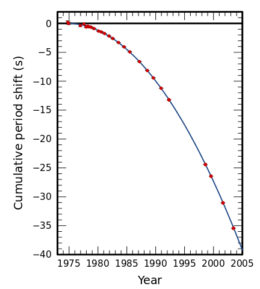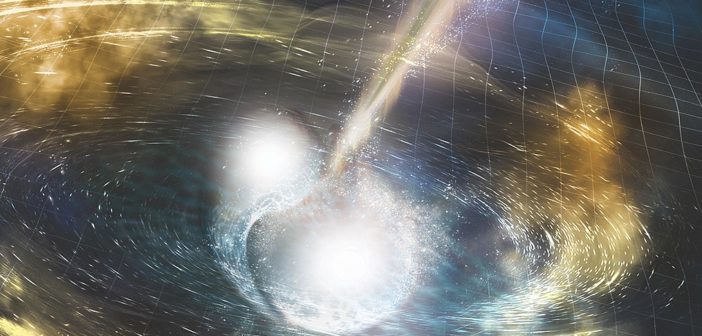How do we find extraterrestrial intelligence (ETI) — not just life beyond Earth, but advanced extraterrestrial civilizations? One approach is to seek signals from ETI that may be attempting to communicate with us — but the problem of where, when, and how to look for such communications is a complex one. A new study explores one way we could optimize this hunt: by searching for communication signals that are synchronized with the merger of two neutron stars.
“Hey, Look Over Here!”

Schematic of how ETI in a distant galaxy could send a communication that would arrive at Earth (receiver) at the same time as the signal from the merger of two neutron stars in the ETI’s galaxy. The distance l between the ETI and the merger is much shorter than the distance between their galaxy and Earth. [Nishino & Seto 2018]
But this strategy requires the ETI to predict the instant such an explosion near them — i.e., within the same galaxy — would occur, far enough in advance that they can send a communication signal that will arrive here on Earth at the same time as the transient signal.
Conveniently, there’s a bright transient that can be predicted in advance: the electromagnetic and gravitational-wave radiation from the merger of two neutron stars. In a new study from Kyoto University in Japan, researchers Yuki Nishino and Naoki Seto explore a scenario in which extragalactic intelligent life synchronizes a signal to us with a binary-neutron-star merger in their own galaxy.

The orbital decay of the binary neutron star PSR B1913+16 has been precisely measured over decades using the timing of its radio pulses. With this approach, ETI could estimate when a binary in their galaxy will eventually merge. [Inductiveload]
A Merger Predicted
Binary-neutron-star systems — which are prolific across the universe — are often discoverable and measurable due to pulses of light from one or both components of the system. From the exact timing of pulsars in a compact binary system in their own galaxy, ETI could measure the orbit and decay of the binary, allowing them to calculate when the system will merge.
Nishino and Seto argue that the ETI could then target a distant galaxy like ours for a communication signal that would arrive at roughly the same time as the gravitational-wave burst from the merger.
Powering Up
What kind of technology is needed for such a signal? The authors estimate that, for a civilization in a galaxy 130 million light-years away, ten megabytes of data could be sent to a receiver like the Square Kilometer Array on Earth using a ~1 terawatt radio transmitter. A terawatt is a lot of power — it’s 10% of the current energy consumption on Earth — but Nishino and Seto argue that such outputs are not out of reach for advanced civilizations.

Artist’s impression of the antennas in the 5-km central core of the future Square Kilometer Array. [SKA/Swinburne Astronomy Productions]
Citation
“The Search for Extra-Galactic Intelligence Signals Synchronized with Binary Neutron Star Mergers,” Yuki Nishino and Naoki Seto 2018 ApJL 862 L21. doi:10.3847/2041-8213/aad33d
